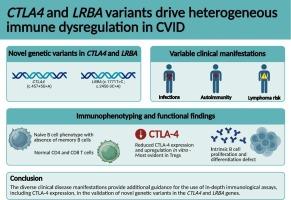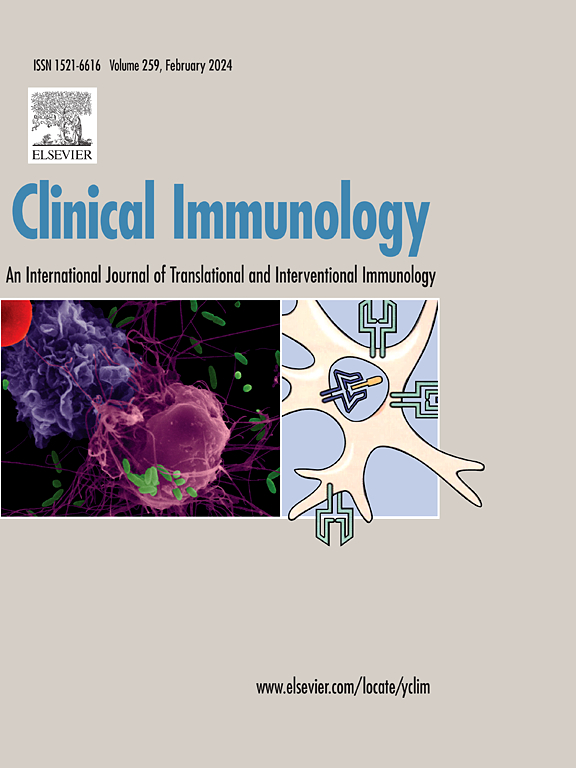CTLA4和LRBA免疫失调的新致病变异:CTLA-4表达降低,共刺激表面分子表达正常。
IF 3.8
3区 医学
Q2 IMMUNOLOGY
引用次数: 0
摘要
背景:细胞毒性t淋巴细胞相关蛋白4 (CTLA4)和脂多糖反应性米色样锚蛋白(LRBA)的遗传变异参与相同的生物学途径,与常见变异性免疫缺陷障碍(CVID)的单基因原因有关。识别CVID的缺陷可能与CTLA-4单倍功能不全或LRBA缺乏有关,这是一种非常不均匀的临床表现。在本研究中,我们通过对5例CTLA4和LRBA新基因变异患者的临床和免疫学分析来说明这一挑战。方法:采用全外显子组测序(WES)鉴定患者目前已知免疫基因的遗传变异。广泛的免疫表型、淋巴细胞增殖试验和CTLA-4和17个共刺激分子的表达,在静止和激活时,进行,以深入了解遗传变异对B和T细胞表型和功能的影响。结果:在一个家族的三个成员中发现了一种新的CTLA4杂合变异(c.457 + 5G > A),均表现出不同的临床表现。在另外两名患者中,LRBA有两种遗传变异(C .1771 T > C;发现了c.2450-3C > A),其中一个也是新的。B细胞表型为naïve,除无任何临床表现的遗传影响的老年妇女外,所有患者均无非开关和开关记忆B细胞。CD4、CD8 T细胞数量及表型正常。B细胞向抗体分泌细胞的分化在体外被减少,特别是在对T细胞非依赖性刺激的反应中。T细胞显示CTLA-4表达上调受损,在CD4+CD25+FoxP3+调节性T细胞中最为明显,这有助于生物学上支持遗传诊断。结论:所描述的CTLA4和LRBA的新遗传变异显示免疫影响,因此可能是具有高度可变临床表现的免疫失调综合征的基础。除了活化T细胞的免疫表型异常发现外,内在的B细胞缺陷有助于解释这两个基因在高度可疑的临床表现背景下的新遗传变异。本文章由计算机程序翻译,如有差异,请以英文原文为准。

Novel pathogenic variants in CTLA4 and LRBA immune dysregulation: Reduced CTLA-4 expression with normal expression of co-stimulatory surface molecules
Background
Genetic variants in Cytotoxic T-Lymphocyte-associated protein 4 (CTLA4) and LPS responsive beige-like anchor protein (LRBA), involved in the same biological pathways, are implicated as monogenic causes of Common Variable Immunodeficiency Disorder (CVID). The pitfall in the recognition of CVID possibly related to CTLA-4 haploinsufficiency or LRBA deficiency is a clinical picture that is very heterogeneous. In the present study, we illustrate this challenge by means of clinical and immunological analysis of five patients with novel genetic variants in CTLA4 and LRBA.
Methods
Whole-exome sequencing (WES) was performed to identify genetic variants in the currently known immune genes in patients. Extensive immunophenotyping, lymphocyte proliferation assays and expression of CTLA-4 and a panel of 17 co-stimulatory molecules, both in rest and upon activation, were performed to gain insight into the impact of the genetic variants on B and T cell phenotype and function.
Results
A novel heterozygous variant in CTLA4 (c.457 + 5G > A) was identified in three members of a single family, all presenting with different clinical manifestations. In two additional patients, two genetic variants in LRBA (c.1771 T > C; c.2450-3C > A) were found, of which one is novel as well. The B cell phenotype was naïve with absence of non-switched and switched memory B cells in all patients except of the genetically affected elderly woman without any clinical manifestations. CD4 and CD8 T cell numbers and phenotype were normal. Differentiation of B cells into antibody secreting cells in vitro was reduced, especially in response to T cell-independent stimulation. The T cells showed impaired upregulation of CTLA-4 expression, which was most pronounced in CD4+CD25+FoxP3+ regulatory T cells, which helped to biologically support the genetic diagnosis.
Conclusion
The described novel genetic variants in CTLA4 and LRBA show immunological impact and are therefore likely to underly an immune dysregulation syndrome with a highly variable clinical presentation. Apart from the immunophenotypic abnormal findings in activated T cells, the intrinsic B cell defect aids in the interpretation of novel genetic variants in these two genes in the context of a highly suspected clinical presentation.
求助全文
通过发布文献求助,成功后即可免费获取论文全文。
去求助
来源期刊

Clinical immunology
医学-免疫学
CiteScore
12.30
自引率
1.20%
发文量
212
审稿时长
34 days
期刊介绍:
Clinical Immunology publishes original research delving into the molecular and cellular foundations of immunological diseases. Additionally, the journal includes reviews covering timely subjects in basic immunology, along with case reports and letters to the editor.
 求助内容:
求助内容: 应助结果提醒方式:
应助结果提醒方式:


